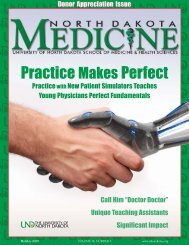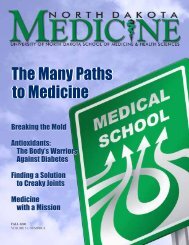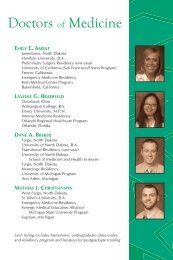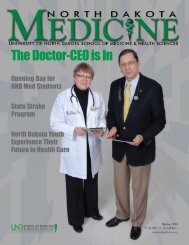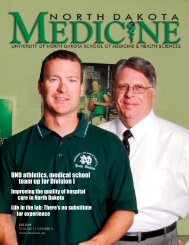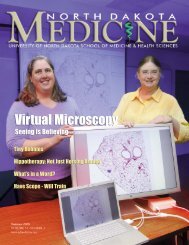Touching Lives Touching Lives - North Dakota Medicine
Touching Lives Touching Lives - North Dakota Medicine
Touching Lives Touching Lives - North Dakota Medicine
You also want an ePaper? Increase the reach of your titles
YUMPU automatically turns print PDFs into web optimized ePapers that Google loves.
“<br />
Brain injury<br />
”<br />
isn’t obvious<br />
like a broken leg<br />
“Many individuals with traumatic brain<br />
injuries and their families go without<br />
help regarding the long-term issues that<br />
they face,” Quinn said. “By creating a<br />
coordinated system to access, adequate<br />
services and support can be provided.”<br />
The Center for Rural Health administers<br />
the TBI project, in partnership with the<br />
<strong>North</strong> <strong>Dakota</strong> Department of Human<br />
Services. Additional funding partners<br />
include the <strong>Dakota</strong> Medical Foundation,<br />
the <strong>North</strong> <strong>Dakota</strong> Head Injury<br />
Association and the Anne Carlsen Center.<br />
The TBI project is improving screening<br />
and referrals for needed services and<br />
service coordination. It also aims to<br />
strengthen cultural awareness, implement<br />
a peer-mentoring pilot program involving<br />
American Indians, promote education<br />
and awareness, target medical education,<br />
and develop a resource library.<br />
Resources may also be used to explore<br />
ways to track the incidence of traumatic<br />
brain injuries in <strong>North</strong> <strong>Dakota</strong>.<br />
Nationally, the Centers for Disease<br />
Control estimates about two percent of<br />
the population is affected by traumatic<br />
brain injuries that disrupt the normal<br />
function of the brain. Using this<br />
estimate, about 12,800 <strong>North</strong> <strong>Dakota</strong>ns<br />
have brain injury-related disabilities.<br />
“That is a significant number of people<br />
living in <strong>North</strong> <strong>Dakota</strong> with what we<br />
call ‘the invisible injury’,” notes Quinn.<br />
“Brain injury isn’t obvious like a broken<br />
leg. People who have experienced a<br />
brain injury will often appear normal,<br />
and they or the people around them<br />
don’t understand why they are acting or<br />
feeling differently.”<br />
To the rest of the world, Hannah<br />
Anderson looks like your average<br />
teenager—only the people close to her<br />
know the challenges she faces on a<br />
daily basis due to her brain injury. But<br />
with her continued hard work and the<br />
dedication of a project designed to create<br />
a better support network for people<br />
who share her condition, there is hope.<br />
“This program will help so many<br />
people,” she said. “I want all of us to<br />
have a better life.”<br />
-Tara Mertz<br />
Traumatic brain injury (TBI) victim<br />
Hannah Anderson and others with<br />
this invisible injury are taking<br />
advantage of a new, centralized source<br />
of TBI information in <strong>North</strong> <strong>Dakota</strong>.<br />
NORTH DAKOTA MEDICINE Holiday 2008 11



